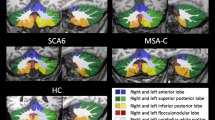Abstract.
Cerebellar atrophy is assumed to be a common finding in patients suffering from epilepsy. Anticonvulsants as well as seizure activity itself have been considered to be responsible for it but many studies have addressed these questions in specialised centres for epilepsy thus having a referral bias towards patients with severe epileptic syndromes. The purpose of this study was: 1. To develop a quantitative method on 3D-MRI data to achieve volume or planimetric measurements (of cerebrum, cerebellum and cerebellar substructures). 2. To investigate the prevalence of cerebellar atrophy (and substructure atrophy) in a prospectively investigated population-based cohort of patients with newly diagnosed and chronic epilepsy. 3. To quantify cerebellar atrophy in clinic-based patients, who had had atrophy previously diagnosed on routine visual MRI assessment. 4. To correlate the measures of atrophy with clinical features in both patient groups. A total of 57 patients with either newly diagnosed or chronic active epilepsy and 36 control subjects were investigated with a newly developed semiautomated method for cerebral as well as cerebellar volume measurements and substructure planimetry, corrected for intracranial volume. We did not find any significant atrophy in the population-based cohort of patients with newly diagnosed epilepsy or with chronic epilepsy. Visually diagnosed cerebellar atrophy was mostly confirmed and quantified by volumetric analysis. The clinical data suggested a correlation between cerebellar atrophy and the duration of the seizure disorder and also the total number of lifetime seizures experienced and the frequency of generalised tonic-clonic seizures per year. Volumetry on 3D-MRI yields reliable quantitative data which shows that cerebellar atrophy might be common in severe and/or longstanding epilepsy but not necessarily in unselected patient groups. The results do not support the proposition that cerebellar atrophy is a predisposing factor for epilepsy but rather are consistent with the view that cerebellar atrophy is the aftermath of epileptic seizures or anticonvulsant medication.
Similar content being viewed by others
Author information
Authors and Affiliations
Additional information
Received: 26 September 2001, Received in revised form: 15 February 2002, Accepted: 15 April 2002
Present address: Dept. of Neurology, Friedrich-Schiller University, 07740 Jena, Germany, Tel.: +49-36 41/93 67 64, Fax: +49-36 41/93 46 99, E-Mail: hagemann@med.uni-jena.de
Correspondence to G. Hagemann, MD
Rights and permissions
About this article
Cite this article
Hagemann, G., Lemieux, L., Free, S. et al. Cerebellar volumes in newly diagnosed and chronic epilepsy. J Neurol 249, 1651–1658 (2002). https://doi.org/10.1007/s00415-002-0843-9
Issue Date:
DOI: https://doi.org/10.1007/s00415-002-0843-9




